Chapter 9 Predicting futures in the IoT
“Let us think the unthinkable, let us do the undoable, let us prepare to grapple with the ineffable itself, and see if we may not eff it after all.”
— Douglas Adams, Dirk Gently’s Holistic Detective Agency (1987)
9.1 Introduction
Where the Internet of Things Board Game succeeded in effectively conveying the underlying complexity of interdependencies within IoT through a procedural rhetoric in play, it was unable to sufficiently illuminate the influence of object-oriented philosophy within the research. The goal for the artefact was to apply concepts coming from the inter-spatial model devised in Chapter 7, in an attempt to understand them and possibly convey them to others. The ideal would have been for players of the game to view IoT objectively and perhaps if played by designers view the design of IoT in a new way. In the process of designing the game this rhetoric needed to be balanced with playability which resulted in effectively distancing it from philosophical discourse, the inclusion of which could have allowed for more in depth scrutiny of the model. To truly explore a more-than human perspective of IoT, it deemed useful to attempt crossing the human/non-human threshold and welcome in the philosophical discourse further.
This next and final artefact is an attempt at doing just that. In this chapter, I will be introducing the Tarot of Things, a bespoke set of tarot cards designed to provide a glimpse into the inner lives of IoT objects. Similar to the attempt at auto-experience sampling in Chapter 4 to observe a phenomenological perspective of objects and their experiences, this artefact attempts to present an object-oriented perspective of IoT objects by proposing a manner of agency.
In this chapter the artefact is presented in three parts the first being the designed cards, second understanding the means of interacting with the cards, and third an accompanying work of design fiction exploring their use. Collectively they embody an abstract concept of a supernatural presence of/for IoT. The cards are designed with the intention to be used by IoT objects and thus the purpose here is to present this abstraction as an aid towards divorcing oneself from one’s humanness, an equally abstract and difficult proposition. For this reason this chapter returns to philosophy to explain the design choices and reasoning behind the artefact.
The concept of agency in objects is a tricky prospect and battled with in numerous philosophical texts. As such, this research from the start does not argue for the presence of agency within inanimate objects, rather it proposes the use of philosophy as a lens to view the world as if it were to have such attributes. The model considered this through alternative spatial configurations touching on a thing geography, and to approach this objective vantage point this artefact touches on post-phenomenology to view human-technology relations through philosophy.
Unlike the board game this artefact embodies carpentry in a purer sense by designing through philosophy in order to retain the prospect of scrutiny and wider discussion. It also enforces the spatial configurations further by locating the perspective as being from within the objects. In the coming text post-phenomenological discourses will be supplemented by object-oriented views of understanding the inner workings of objects, to allow this seeing out from within. In order to facilitate this the earlier understandings of digital/non-digital spaces are revisited, and iterated upon as perceptual illusions.
The referencing of illusions here is done as a realignment of perspectives in order to accommodate object-oriented-ness for humans. Also unlike the board game this is a truer ludic design artefact as described through explorations by Gaver (2002) of designing through engaging curiosity. This might feel confusing to say the board game was a less ludic artefact when it involved play more directly but it is for that reason that I consider it less Gaver’s ludic design. The board game required play and thus it was a ludic artefact, and due to the nature of its design curiosity and ambiguity could not be fully incorporated to illicit the manner of engagement Gaver speaks of in his design process. Therefore, the Tarot of Things was an attempt to do that more directly. Collectively, this creates the carpentry method assemblage used in this chapter (Fig. 9.1).
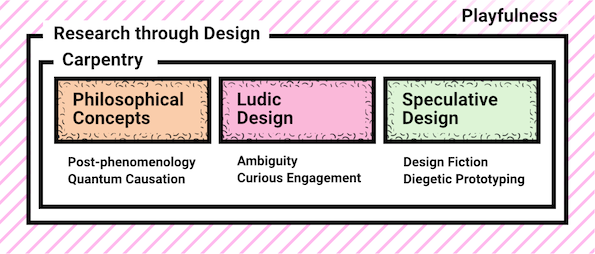
Figure 9.1: The method assemblage for the carpentry of this artefact combine concepts coming from post-phenomenology to explore a more directly playful approach at speculative diegetic prototyping methods.
Having said that, this artefact incorporates the core rhetoric of an attitude of playfulness in design proposed by this thesis more proudly, as will be discussed further towards the end. Through its discussion on more-than humanness and IoT this chapter also attempts to address SQ3: How can the philosophical foundations of a proposed non-anthropocentric IoT be manifested in RtD artefacts? Towards the end the cards are evaluated using a software interfacing approach and through role-played user feedback, to argue for seeing the world through these more-than human object perspectives which reflects back to the RtD approach used throughout this thesis. To begin I will be revisiting some earlier explained philosophies.
9.2 Philosophical Foundations
In Chapter 4, I spoke of the Talkie Toaster from 90’s British sitcom Red Dwarf, making a parallel between the toaster and its real-world counterparts 57. Using an object-oriented perspective, Talkie Toaster can be approached as a more-than human object asking questions to how and why it functions the way it does. For instance, what does Talkie Toaster want from life? What does it do when it’s not toasting? These questions may be considered nonsensical from an anthropocentric perspective, as a non-human object cannot be imbued as having such aspirations. However, this research takes playful liberties with such arguments and if considering design as an act of playfulness then what better way than to make sense of the nonsensical 58.
Ludic design’s engagement of curiosity and ambiguity through design may be better utilised for this to allow for facilitating abstract discussions. Thus, to carpenter an artefact that utilises the ambiguity and playfulness of ludic design, certain deeper philosophical arguments around more-than humanness need to be further explored starting with vicarious causation (Harman 2018, 150). In Chapter 4 I presented OOO’s perspective of viewing out from within through the argument posited by Harman (2018) of rifts existing between ontological polarities an object can take, presenting miniature worlds within/among objects full of relationships and perspectives. We know that within these rifts non-human-objects exist side by side human-objects, to be unpacked as independent and interdependent phenomenon. By this logic, when using a Fitbit to track a heartbeat its interaction is not directly related to the human even though that is how it appears. This interaction is with fluctuations in light observed by a sensor with no need of a heartbeat. That said, the Fitbit’s heart monitor was not designed to interact with light specifically. As design concerns with the human perspective, light is the medium it interfaces with to deduce a ‘human’ heartbeat, making the Fitbit an anthropocentric object. The question to ask here is, how can we see the Fitbit as not relating to human engagement? Divorcing of an anthropocentric perspective thus boils down to a change in perception towards post-anthropocentrism.
An examination of perception is a heavy undertaking that has occupied philosophy for centuries with a great deal of literature devoted to the subject (Maund 2003; Merleau-Ponty 1996; Pautz 2007; Price 1950; Fish 2010). Some of these notions have been covered in Chapter 4, therefore the discussion here will focus on the perception of technology through notions of post-phenomenology to approach the human/non-human threshold in respect of IoT. Rather than go into a deep exploration of these concepts,59 the two areas of interest in this discussion come from the work by Ihde (1990) on human-technology relations and an appropriated perspective of illusions. My intention here is to present a case for vicarious causation as occurring within digital objects through understanding post-phenomenological perspectives and how our present perceptions of technology might be misaligned for the philosophical discourse of this research.
9.2.1 The Perception of Technology and Post-Phenomenology
The influential work by Ihde (1990) around a contemporary philosophy for human-technology relations fall under the heading of “post-phenomenology” (Rosenberger and Verbeek 2015b, 9). This depart is done in an attempt to distance post-phenomenological views from those of traditional phenomenology 60. Explaining the post-phenomenological perspective, Verbeek and Kockelkoren (1998) posit a combination of philosophies coming from both a Heideggerian functionalist view of readiness-to-hand for objects, to American philosopher Albert Borgmann’s concept of engagement with objects. Quoting Ihde’s appropriation of Merleau-Ponty’s term he calls it the “embodiment of objects”61 (1998, 39) in what is argued as a mediating role played by objects to facilitate the world around them for us, often through their design. “When using a pair of glasses, we do not look at our glasses, but through them to the world” (1998, 39).
As an example for how our perception of technology may change due to our relationship with it, Verbeek and Kockelkoren (1998, 38) replace Heidegger’s oft quoted hammer with an adapter commonly found with digital objects such as mobile phones. As long as the wire on the adapter is unbroken it performs in a readiness-to-hand absorbed into our background lives. It becomes apparent to us only when the wire is broken making the adapter present-at-hand. The relationship changes as the adapter breaks the familiar bond it once had for a “distanced attention” (1998, 39) drawing us towards it. They consider these objects transparent as they bind together relationships between people and their worlds. Taking this further they present Borgmann’s views of technological objects as capable of “diminishing people’s engagement” (1998, 40), as they are designed to disburden users from mundane activities functioning best with little human involvement and unnoticed. The adapter is thus designed to fade away into the background reducing engagement with them into a form of consumption.
Verbeek and Kockelkoren (1998, 40) argue that the broken adapter effectively withdraws us from the world we inhabit with it because our collective involvement comes from its functional nature. Our relationship with the adapter is not as an object of meaning but resides in functional fulfilment. These technological objects are not asking for engagement as they are not designed to. He compares this to an example of a piano. The piano’s existence is predicated around the music it can emit. It has no direct relation to that around it, but rather, it is through the act of playing the piano that it becomes what it is. The piano engages us in order to fulfil its function.
“Rather than thinking in terms of alienation, it [post-phenomenology] thinks in terms of mediation. Science and technology help to shape our relations to the world, rather than merely distancing us from it. This perspective of mediation embodies a reinterpretation of the foundations of phenomenology. It does not see phenomenology as a method to describe the world, but as understanding the relations between human beings and their world.” (Rosenberger and Verbeek 2015a, 11)
The argument Verbeek and Kockelkoren (1998) posit for post-phenomenology through this concept of embodiment and engagement regards out relationships with the technologies that surround us. They stress a need to design objects around their “engaging capacity” (1998, 41), revaluating their status from objects to artefacts requesting human involvement. Though this might still seem like an anthropocentric approach, it exists in an overlap between Harman’s OOO and a view of post-phenomenology. OOO is in many ways a like-post-phenomenological approach, wherein, it refutes prior theories to craft its unique brand of thought presenting a platform for thinking in a post-phenomenological way 62.
Among the mediations of technology presented by Verbeek (2005, 127) is a notion of Background Relations or technological relations that exist in our peripherals. He argues for these not as technologies that have become mundane through usage, rather, those that create the backgrounds of our lives as the refrigerator, microwave, Google Nest, or light sensors: “They shape our experiences, protecting us from the elements or keeping our food safely chilled, but do so in ways that do not require direct interaction” (Rosenberger and Verbeek 2015a, 19). These technologies facilitate our lives through their presence as they act out their own independent lives. Sensors seek us out as smart heaters keep us warm engaging with us as much as we reciprocate with them.
9.2.2 Human-Technology Relations as Perceptual Illusions
Another perspective that could be taken here is that by viewing the world through this post-phenomenological lens, a perception of objects may be crafted presenting them as embodying illusory interactions. By illusion I am referring to incorrect evaluations of perceptual experiences (Fish 2010, 3); such as seeing a round object as an oval. What I am suggesting is that as user-objects ourselves, the interactions (or anticipation of interactions) we have with these objects of the Internet may be misguided forming perceptual illusions.
The study of perceptual illusions is often seen in cognitive psychology as it relates to how effects on our biology alter our perception; and as Gregory (1997) differentiates, may be of a physical or cognitive nature. The most common example of such is dipping a stick into water. Due to the refraction of light when entering a liquid such as water (a physical property), the stick appears broken (a cognitive formulation). A stick entering water thus gives us a level of anticipation associated with the stick coming from its dimensional aspects 63.
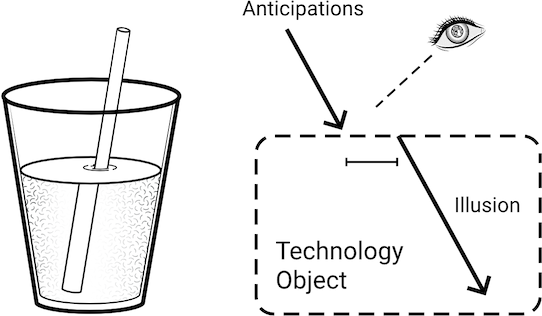
Figure 9.2: The stick in water does not truly bend, yet upon doing so we acknowledge it as such. This is similar to how our anticipations from technologies foster through our developed illusions of them.
What I am referring to through ‘anticipations’ in this way is our specific views towards how we engage with technological objects. Combined with the post-phenomenological discussion above, this metaphor presents an example of seeing the background relations of objects as possible perceptual illusions (Fig. 9.2). Furthermore, using the constellation metaphor by J. G. Lindley and Coulton (2017) an ontographical view of how and why these illusions occur could be charted. By being able to see the stick bend our mind acknowledges it as having altered and prepares us for the next time we interact with the water, further informing us of the nature of the stick and water. Similarly, the anticipation of interaction with our devices presents us with the idea of how they must conform. The adapter must function as expected and going in with it we take that anticipation along. Yet one need not be aware of the refrigerator in the background to acknowledge its function just as the smart heater may operate on its own after minimal human input. It is only when certain conditions are met that the illusion is broken such as being aware that the smart heater is also sharing data without consent to third-parties. This is equivalent to removing the stick from water. As these technological objects have existed prior to their ‘smart’ counterparts our associations with them have been crafted over time. We are aware of the refrigerators functions before it can facilitate us in ‘smarter’ ways.
This is not to say our smart devices are providing us with false information. The stick does not bend in water it merely conforms to the properties of light and the liquid. In his metaphor the technological object becomes the liquid, and our anticipation of interactions forms the illusion. The Fitbit is not reading a heartbeat, it is only reading fluctuations in light. Thus, by acknowledging the presence of our devices as background relations existing in their own right, we remove preconceived anticipations to make way for deeper meaning associations with these IoT objects. For example, how a Fitbit does not require human intervention to be a Fitbit, it is the nature of the design of IoT to accommodate the human perspective of these devices. They operate independently facilitated by the data provided to them as J. G. Lindley, Coulton, and Akmal (2018) put it:
“Whilst human object and the device object are, of course, relevant, it is the data object(s) that appear central to the issues here; they are the containers and carriers for the information to which we attach ethical and moral significance.” (J. G. Lindley, Coulton, and Akmal 2018, para. 31)
The human/non-human divide may now be crossed if, (a) they are acknowledged as independent entities existing in the backgrounds, and (b) their operations are acknowledged beyond anthropocentric functionality and our anticipations of interactions with them. As the data object is what drives IoT, therefore for a carpentered ludic artefact to acknowledge an object-oriented perspective the relationship of data to the object is what needs to be understood, as it should help in informing the world in which the object exists.
9.2.3 Quantum Causation for IoT
The simplest way of making this relation visible through OOO is using quantum causation 64. The four-fold model by Harman (2010c) presented in Chapter 7 explores tensions between the real and the sensual as time, space, essence, and eidos65 in an attempt to approach this deeper idea of causation using quantum physics (Weir 2020). The point made is that an objects interactions occur on an atomic level with particles rearranging themselves as needed. Explorations in the quantum realm are still in early stages, but when the matter of space is discussed in quantum physics it is not considered ‘empty’, instead, accepted as harbouring virtual particles (2020, 152). Morton (2013) presents an in-depth argument for this on the impossibility of space independent of objects. Quantum causation suggests a platform where non-human real objects can have sensual objects within them, much like how human real objects can. Using Harman’s favoured OOO example of cotton and fire, a notion of non-human perception happening through the interactions of quantum particles could suggest why cotton understands it must burn when interacting with fire.

Figure 9.3: A quantum causation of IoT objects can be imagined through metadata acting as virtual particles just as atoms and molecules create the foundations of causation in the physical world.
Much like the perceptual illusions we have with our objects, this suggests objects have their own anticipations of other objects when they engage. This wrapping of objects within objects mimics the way spaces are defined in the model for IoT as heterotopias, therefore, the quantum realm can be substituted in our case for the digital with data as its particles (Fig. 9.3). Hui (2016, 48) presents an argument for digital objects to be seen as phenomenological objects in this way by charting a relationship between the underlying workings of digital interactions and phenomenological implications around the perception of technology in what is considered a “Genesis of Digital Objects” (2016, 49). Code and metadata in this perspective may be seen as constructs intended as ontologies of data and a digital object. Unseen to the user in this quantum-digital space, each bit of information acts as giving a kind-of life to the otherwise non-living.
Through the model presented in Chapter 7 the digital has already been established as an alternative space existing parallel to the non-digital. With the information housed in these digital particles, objects in the digital understand when to fuse with other IoT objects creating their perceptive illusions. The adapter understands electrical current as much as the smart phone does. In a similar light, the smart heater understands fluctuations in temperature coming from its sensors in order to regulate the atmosphere it controls, as objects transcend quantum causation between digital/non-digital realms.
While exploring the constellations in IoT J. G. Lindley, Coulton, and Akmal (2018, 236) examined how data was communicated between individual entities in an IoT network using Wireshark a network protocol analyser. The sheer volume of information going between different points coming from a single computer on the network was found to be staggering and when each packet of information was seen as OOO unit operations similarities were found. A hexadecimal language full of metadata spoken between the different networked objects as they understood each other creating building blocks for their interactions and their individual perceptions of each other. The kettle knew and was aware of the smart lock on the network as did the smart phone. Amidst all these interactions were possibly non-digital causation translated for the digital as well; think temperature, time, pressure, etc.
This myriad of philosophical lenses presents similar building blocks for allowing IoT objects to be seen as capable of relations with other objects, human or non-human. With the philosophical foundation for this artefact in place we can begin carpentering the Tarot of Things to facilitate object-oriented relations and anticipations. The artefact intends to bridge the human/non-human threshold by allowing a means of ‘reading’ IoT as being more-than human, and seeing objects in a way that is playful yet insightful.
9.3 Carpentering the Supernatural IoT
For this artefact our carpentry toolbox takes directly from the philosophical foundations described above to attempt creating abstract perceptual realities for IoT objects. To achieve that I use the word ‘supernatural’ here in reference to the usage of the term “ghosts” residing ‘in’ IoT objects by J. Lindley, Coulton, and Alter (2019, 1188), the idea being that where there are ghosts there are (or have been) lives; pasts, presents, futures. As this process is intended to be playful to incorporate the philosophy as broadly as possible, this approach of exploring the vicarious lives of digital objects may be done through acknowledging their aspirations and futures. Since the two main aspects coming from the philosophy include the repurposing of post-phenomenological human-technology relationships (or engaging objects) as illusions of anticipated interactions, and a quantum causation for these digital objects, it is important to establish a baseline on which these concepts may be touched upon sufficiently.
One approach already present in OOO is through enthymeme which Harman uses as a way to structure OOO’s rhetoric 66. Enthymeme are seen as logical reasonings with premises left unstated as it is assumed that the participant understands the major premise, for instance ‘an offer that can’t be refused’ or the giving of a rose being associated with affection. The use of enthymeme suggests the presence of the hidden, thus, it is possible to imagine crafting enthymeme into design practice to explore knowing the unknown; in this case, the supernatural lives of IoT.
In Enchanted Objects, Rose explores the concept of human-human connection through a metaphor of “telepathy” (Rose 2015, 85). The argument he presents is not for the validity of telepathy as a practice, rather about what telepathy implies; an indirect communication where one simply ‘knows’ what the other is thinking. Giving the example of LumiTouch by Chang et al. (2001), a paired picture frame that glows in sync when held, Rose (2015, 85) discusses this possibility of designing to know the unknown. The enchanted interaction of LumiTouch seduces with the curious nature of humans poking at emotions. Its glow affirming the enthymemic rhetoric it intends to present forward: miles away, whoever has the other picture frame is holding it up. Design and enthymeme in this way are very much married together and therefore plausible to incorporate into our carpentry process.
The first step for this baseline is to establish the premise on which our enthymemic design rhetoric will operate. It has to be able to explore both the engagement and aspirations of IoT objects as well as acknowledge inner workings through a quantum causation. For this reason and taking forward the ghost in the machine metaphor from J. Lindley, Coulton, and Alter (2019), the lives of our IoT objects may be imagined through divination or fortune telling.
I won’t be entering into a discourse around the practice of fortune-telling as for this artefact it is but a medium (no pun intended) for exercising the more-than human perspective 67. Fate as a concept is prevalent in many cultures representing a philosophical school of thought, whereby events and actions within our lives are deemed subject to a predetermined course or destiny (Zagzebski 2017). As we are taking playful liberties with IoT to facilitate the more-than human discourse having already presented possible social dynamics among digital objects, this perspective of defining the fates of our IoT objects presents a prospect of the ‘aspiring digital object’.
Interests in divination stem from being human, and the fact that we can contemplate on our lives. But, with some apt usage of speculative design work it is possible to imagine a moment where the rise in autonomous objects may bring about considerable advances in Machine Learning (ML) to harbour divinatory guidance services for IoT devices; digital seer’s if you may.
How this artefact attempts divination is with the most basic form of Tarot, selected for its simplicity over other methods such as reading tea leaves or astrology. Adding to the ludic rhetoric, tarot also made sense as a ‘tool’ under the guise of a card game. It takes 2 to ‘play’ whereby the seer reveals the meaning of chosen cards as if narrating a story. As a reference standard Rider-Waite68 tarot deck was examined consisting of 78 cards69 out of which 22 form the Major Arcana, followed by 4 suits of 14 cards each as Cups, Pentacles, Wands, and Swords. As the theme for tarot is taken from folklore and mythical fantasy, the imagery associated with tarot is of a similar nature. This is most visibly seen in the names and imagery of the major arcana cards: High Priestess, Magician, Hanged Man, etc.
Where tarot’s simplicity works for the purposes of this research is through its inherent practice of rhetoric, with the seer tasked to ‘make sense’ of cards through their meaning associations. Nash (2017) discusses how these associations come from years of evolving classifications of folklore and mythology presented in the visual imagery of the cards. Therefore, the result of a tarot session may be reduced to a list of keywords extracted from card meanings that are independent and interdependent70 effectively creating ontographs. For the purposes of this research this process has been further simplified and an online reference sheet71 used for understanding the meanings of each tarot card. As the meaning associations in tarot are vague and ambiguous promoting their own enthymemic natures with seer’s extracting information from both the cards and the conversation with involved parties, this opens up a wide area of possibility for keyword associations during any given tarot session and a potential for ludic design’s engagement through curiosity and ambiguity.
From the perspective of the above philosophies this divination approach allows for each philosophy to be addressed in the carpentry process. By acknowledging digital objects as having possible fates determined by cosmic (or perhaps network) alignments, they are presumed as engaging with their lives and those involved in it; be they digital or non-digital entities. This in turn also feeds into the rhetoric of possible illusions they might have of their daily interactions. Being programmed and forced to follow algorithms the lives of digital objects may be assumed to be governed by predefined rules. Taking into account potential advances in ML then these rules may also be considered as malleable and capable of evolving, ergo the world perception of digital objects may be equally misaligned as our own as they may accept the presence of other digital/non-digital objects as existing in background relations. The smart toaster may be aware of the presence of human users operating in the backgrounds through their mobile phones, or the smart heater acknowledging the presence of the smart lock through the network. This is all viewable through the constellation metaphor as these objects are connected over the network stressing the point that the lives of digital and non-digital objects are intertwined. Finally, all of these overlapping interactions, acknowledgments, anticipations of interactions, and illusions of background relations are possible through a quantum causation occurring within digital space. The transferring of metadata in the language of IoT asserting their presence among each other, as well as an understanding of certain causation with non-digital objects.
9.3.1 Designing the Deck
With a baseline of tarot now established for this artefact capable of rendering an object-oriented discussion, the next step became understanding what manner of cards could be associated with a more-than human IoT. Furthermore, imagery and symbology associated with the deck need also reflect the ‘world view’ of IoT rather than human folklore capable of instilling in IoT objects the perceptual illusion of their perceived anticipations 72. What I mean by this is that the cards need to reflect how digital objects anticipate interactions in their world as they follow different rules to our own. As humans we understand references such as Death and Strength coming from tarot but what are those equivalents for IoT? Similarly we acknowledge when an object no longer functions as it should, how does that equate for digital objects?
To allow the deck to relate better with IoT each card in the Rider Waite deck was examined separately with its imagery and keyword associations tabulated. The online reference observed for keywords presented multiple associations with cards, some repeating and others differing according to card orientation. The problem occurring here was the fact that many of the keywords were too abstract of concepts to associate with IoT, take for example keywords like pleasure, materialism, and pride. Luckily as each card came with multiple keywords each keyword in a single card would often expand on the previous. For instance, the Judgement card when upright may mean ‘reflection’, ‘reckoning’, or ‘awakening’. As humans we can understand these concepts, and they in many ways are associated with each other depending on contexts. For our purposes this meant systematically picking and choosing which keyword reflected a world view of IoT holistically 73. In this instance ‘reflection’ was opted for as a vague yet translatable middle ground, because a ‘reckoned’ or ‘awakened’ digital object was more difficult to comprehend.
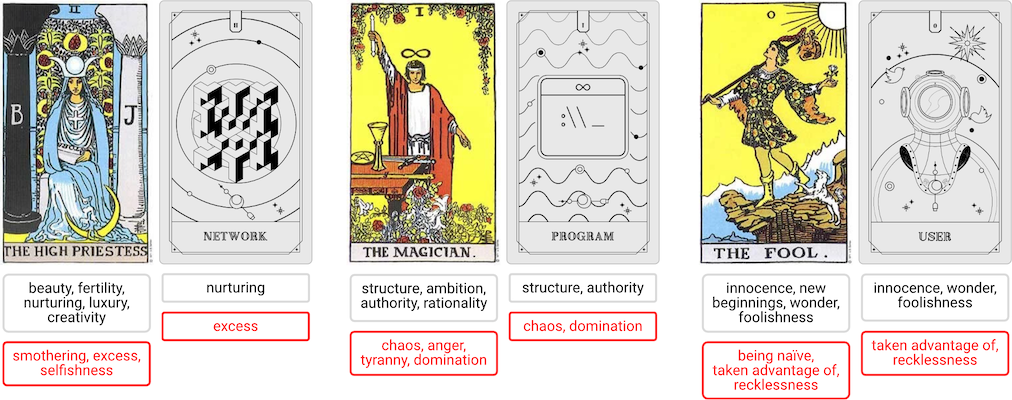
Figure 9.4: Imagery and meaning associations for Tarot of Things were appropriated from standard Rider-Waite tarot cards. Though a deep dive into understanding digital folklore could have been conducted, the process was simplified and through keyword associations of tarot relevant imagery was designed.
The second aspect to tackle was the representation of the cards. The imagery and context of tarot comes from folklore therefore, what kind of similar folklore may exist for digital objects? Rather than go into a deep analysis of how stories and concepts emerge in human folklore this process was simplified by deducing equivalent concepts emerging from human-technology relationships and ideals. To do this the keywords were again referenced to understand what they related best with. So the Emperor card from tarot became ‘The Programmer’ for our deck because the keywords associated with it were ’creation’ and ‘adaption’. Similarly ‘The Fool’ became the’The User’ because its keywords were ‘innocence’, ‘wonder’, and ‘foolishness’. In this way the imagery associated with the cards were also designed in accordance with the new titles of each card. For the most part the design was kept simplistic again referencing styles from Labryinthos Academy’s own Rider Waite deck. An example of some of the cards designed and their referenced Rider Waite cards are given in Fig. 9.4. A full list of all the cards along with their keyword associations are presented in Appendix C.
Finally, an additional ‘Thing’ card was added to the major arcana to represent a means of differentiating this deck as an approximation of tarot. The ‘Thing’ card also intends to directly reference the object-oriented-ness of the interactions being forecasted if it were to be drawn. As typically tarot is intended to relate to the individual having their fortune told and in the language of the cards it is often represented by ‘The Fool’ card, here that card was substituted for ‘The User’ to denote zero precedence between digital/non-digital users.
With a visual language and close approximation of keywords, the deck on its own can be used to represent a tarot-like session. But it is also important to understand where these divinatory sessions would occur and who would be conducting them? To carpenter an artefact for IoT divination the initial thought was to make a ‘physical’ tarot deck. The problem with this is making an IoT object interact with the physical cards. A tarot session involves 3 stages: shuffle, draw, and read. The shuffle stage is done by the one having their fortune read, thus an IoT object would require access and the ability to shuffle a deck of cards. As IoT objects exist in digital space the artefact therefore needed to exist there as well so a physical deck of cards could not work.
9.3.2 Scanning the Stars with Software
The solution for this was to program the Tarot of Things in a way that it could be accessed by digital objects. Due to tarot’s game-like formation programming was done using a Python-based game engine to lay a framework for fundamental interactions (Fig. 9.5) 74. As a popular programming language, Python is capable of easily integrating with other platforms facilitating interactions with IoT 75. The intention became for this carpentered software to act as an independent link between IoT object and the act of fortune-telling; the interface being merely a mode for human facilitation (Fig. 9.5). Devices would ping the software and be presented with a forecast, either of the interaction it underwent or any future interactions.
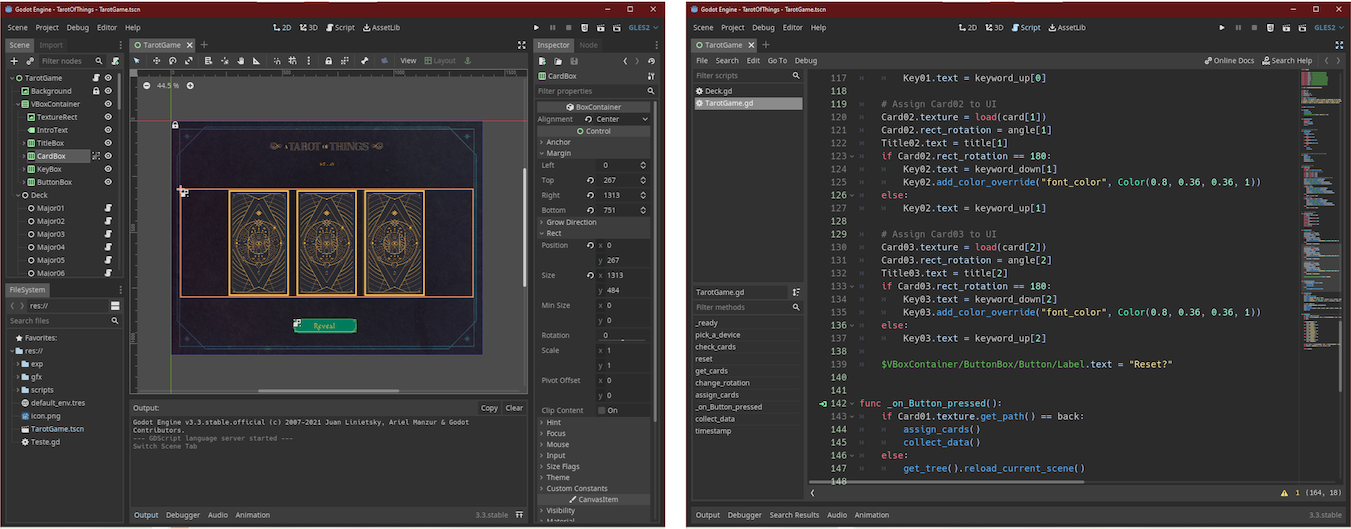
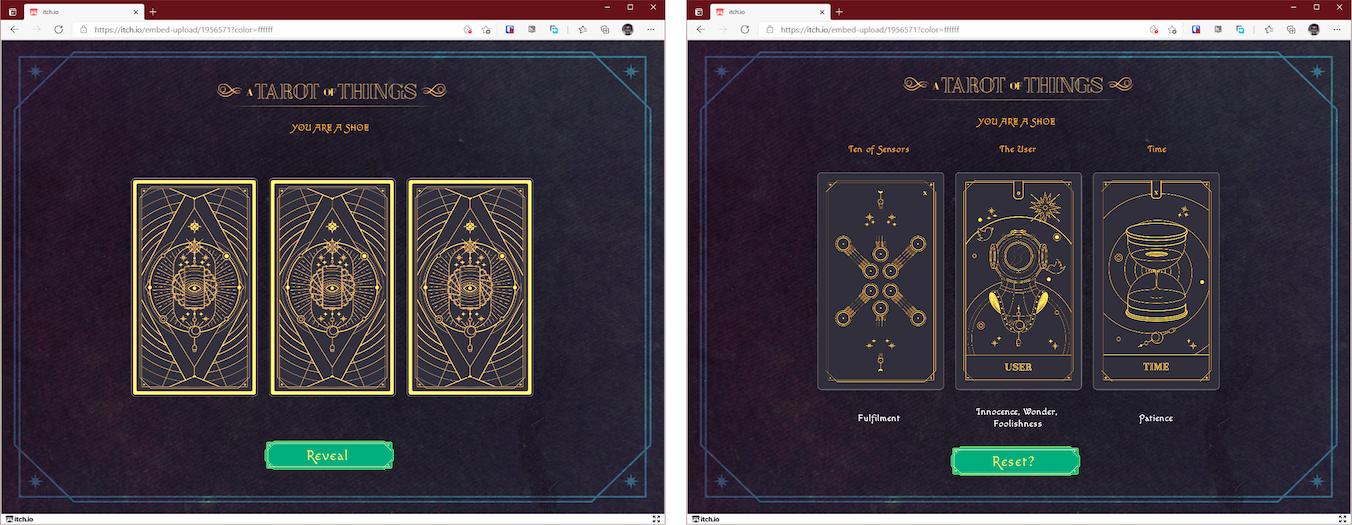
Figure 9.5: Carpentering the Tarot of Things as a ludic artefact; Programming for the artefact was done in Python on the Godot game engine (top); The end result was outputted in two forms as software, one that could be read by humans while the other by IoT objects (bottom).
Programming for a deck of tarot is rudimentary with the deck being assigned to a data set referenced in Python and then iterated on through a series of functions. The interface itself was kept simple since it was only required for research purposes. In the end the program would be self-administrating but for the purposes of testing the interface would prove vital.
9.3.3 A Tarot of Things
The name Tarot of Things is given to not just the deck of cards but also its supporting application. In its human-oriented form76 the application simulates the inclusion of objects by shuffling through a list of non-human objects and presenting the statement “You are a…” followed by the random object. This asserts the agency of the object to be viewed through the cards later drawn. In the final version this would represent the object having its fortune told. Finally, pressing a button reveals the ‘forecast’ which would otherwise be done programmatically in private sessions between software and device.
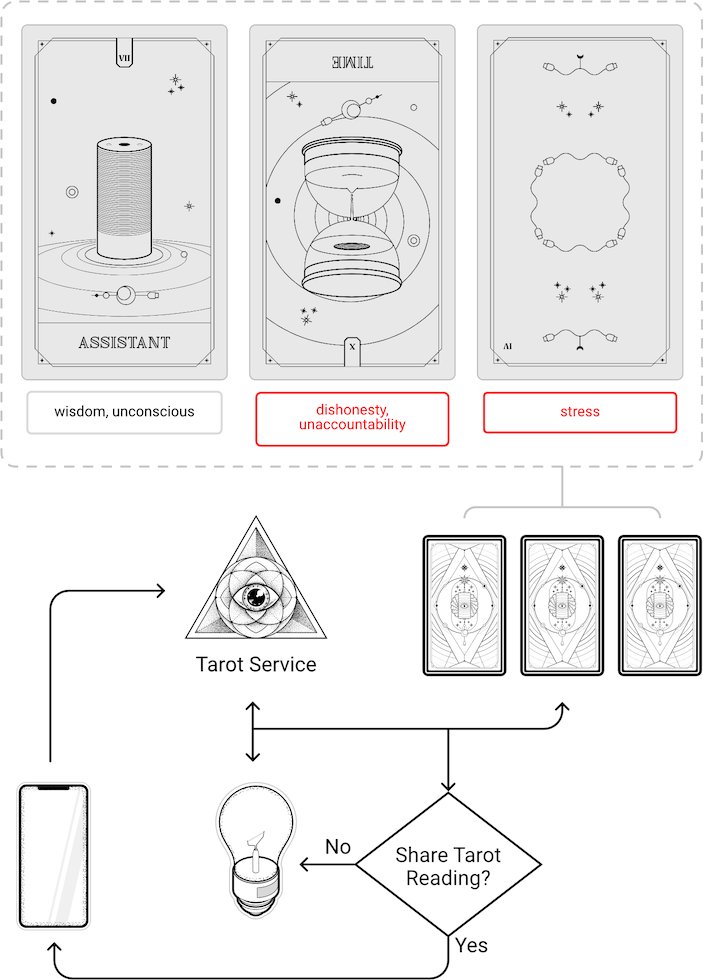
Figure 9.6: Tarot of Things acts as a fortune telling service offered to IoT objects. Through word associations of tarot the digital seer enters into a conversation with the object; ideally occurring independently of any human involvement. In this illustration this is facilitated by the human through a smart phone.
For the purposes of this research these sessions are conducted using the carpentered interface. Through this ‘forecasting’ as keyword reductions ontographical relationships returned may now be assessed through the enthymemic rhetoric of fortune-telling, allowing practitioners to raise questions which would otherwise seem implausible. Consider the example of a lightbulb remotely switched on by a smart phone (Fig. 9.6). The tarot program exists on a network in the cloud accessible by the bulb. Upon switching on the bulb, it pings a server triggering the generation of a forecast. Table 9.1 shows a random configuration of the cards presented. This process also highlights a quantum causation occurring within digital spaces through object engagement. The vicarious lives of our digital objects existing in the backgrounds becoming prominent through the cards with their perceptual illusions manifested. An assessment of keywords raises questions such as, what is wisdom for a bulb? How can one be unconscious? Could a bulb be dishonest or unaccountable? And, what stresses a bulb? Furthermore, the enthymemic rhetoric afforded by fortune-telling between the cards and their meaning associations (Assistant in relation to Time for instance) presents a heightened layer of information regarding the aspiring digital object.
| Cards | Orientation | Keywords(s) |
|---|---|---|
| Assistant | Upright | Wisdom, Unconscious |
| Time | Inverted | Dishonesty, Unaccountablity |
| Four of Cables | Inverted | Stress |
Where some of these questions might seem more straightforward to answer—for example, Dishonesty does it send its operating data to a third party without informing the owner?—others present unique challenges. Of course, all of this is subject to the understanding of the designer/practitioner and how much interpretation is allowed. But it does provide a useful starting point for the discussions which otherwise would likely not be considered under pretences of orthodox HCD methods. Some of these questions might very well lead to novel design solutions from an object-oriented perspective.
9.3.4 Madame Bitsy’s Emporium
As earlier expressed, this chapter includes a design fiction to explore Tarot of Things as a means of presenting the object-oriented aspect further. In its current format, it facilitates the human practice of seeing through a more-than human lens. Design fiction pushes the boundaries of Tarot of Things into a near-future where IoT objects are provided independent divination services imagined as a fortune-telling mobile app. The fictional app provides both divination services to IoT objects, and upon receiving permission from the objects presents that information to human cohabitors.
As a basis for this service, the fiction takes advantage of the many ‘fortune-telling’ and ‘psychic’ apps available on smart phones intended for humans (Fig. 9.7). Among those apps, the work of fictional start-up Gaaps is presented with the purposefully flamboyant title of Madame Bitsy’s Fantastic Future Forecasting and Fortune Telling Emporium for the Internet of Living Things (Fig. 9.7). Unlike other applications claiming psychic prowess that target humans, Madame Bitsy’s clientele are IoT objects and services. The intention here is to provide human-readable forecasting of futures for human cohabiters of digitally empowered IoT objects.
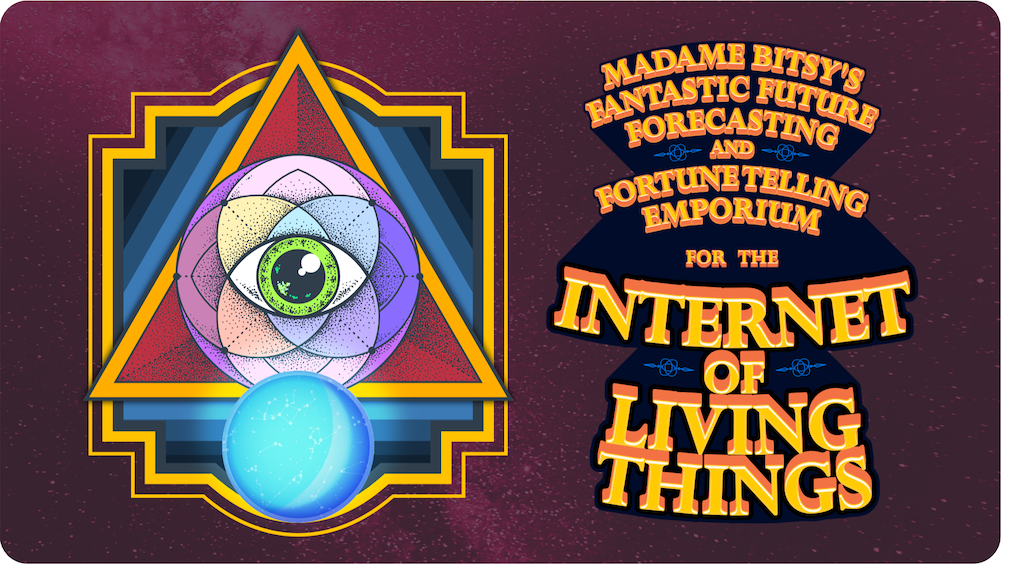
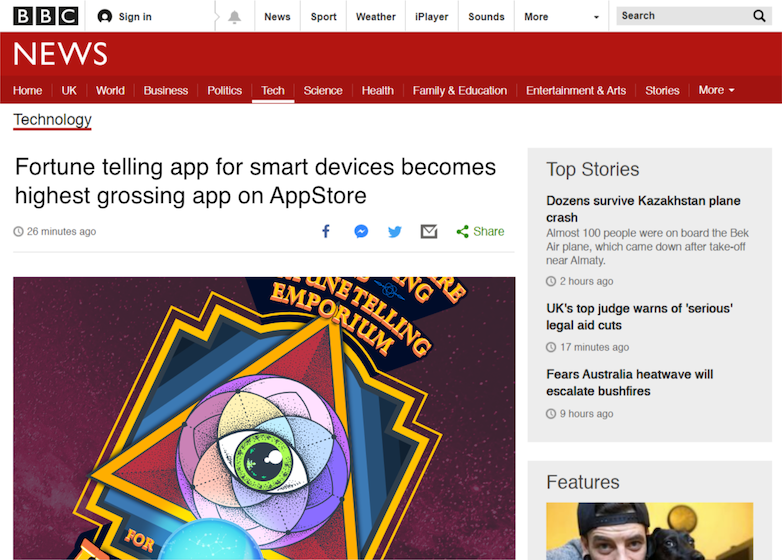
Figure 9.7: Design fiction for exploring Tarot of Things; Branding for Madame Bitsy’s Fantastic Future Forecasting and Fortune Telling Emporium for the Internet of Living Things (left); Fictional news clipping designed for world-building purposes of speculative fiction (right).
The character, name, and aesthetic intentionally fuels the world-building aspect associated with design fictions (Coulton et al. 2017) presenting IoT objects as ‘living objects’ by Madame Bitsy. The application itself resides on a human cohabiters’ mobile device, requiring access to nearby IoT devices. Initiation of a divination session remains independent of the human thereafter in order to keep the personal privacy of IoT objects in mind 77. As such, interaction during the session is done software to software within digital space. Traditionally this link is done in-person between seer and client and begins with a shuffling of the tarot deck by the client; in this case, shuffling is done by the device through a series of pings between itself and Madame Bitsy. Once the digital deck is shuffled the cards are revealed to the device through a series of questions akin to two chatbots speaking amongst each other. Upon receiving a ‘response’, a final permissions check is done between seer and client before articulating the session for human presentation. The translation uses an appropriated Tarot of Things interface and the deck of cards. With the information purposefully skewed to aid in the believability of fiction, the translation is presented in as legible a manner as possible to be read as what the device’s future holds.
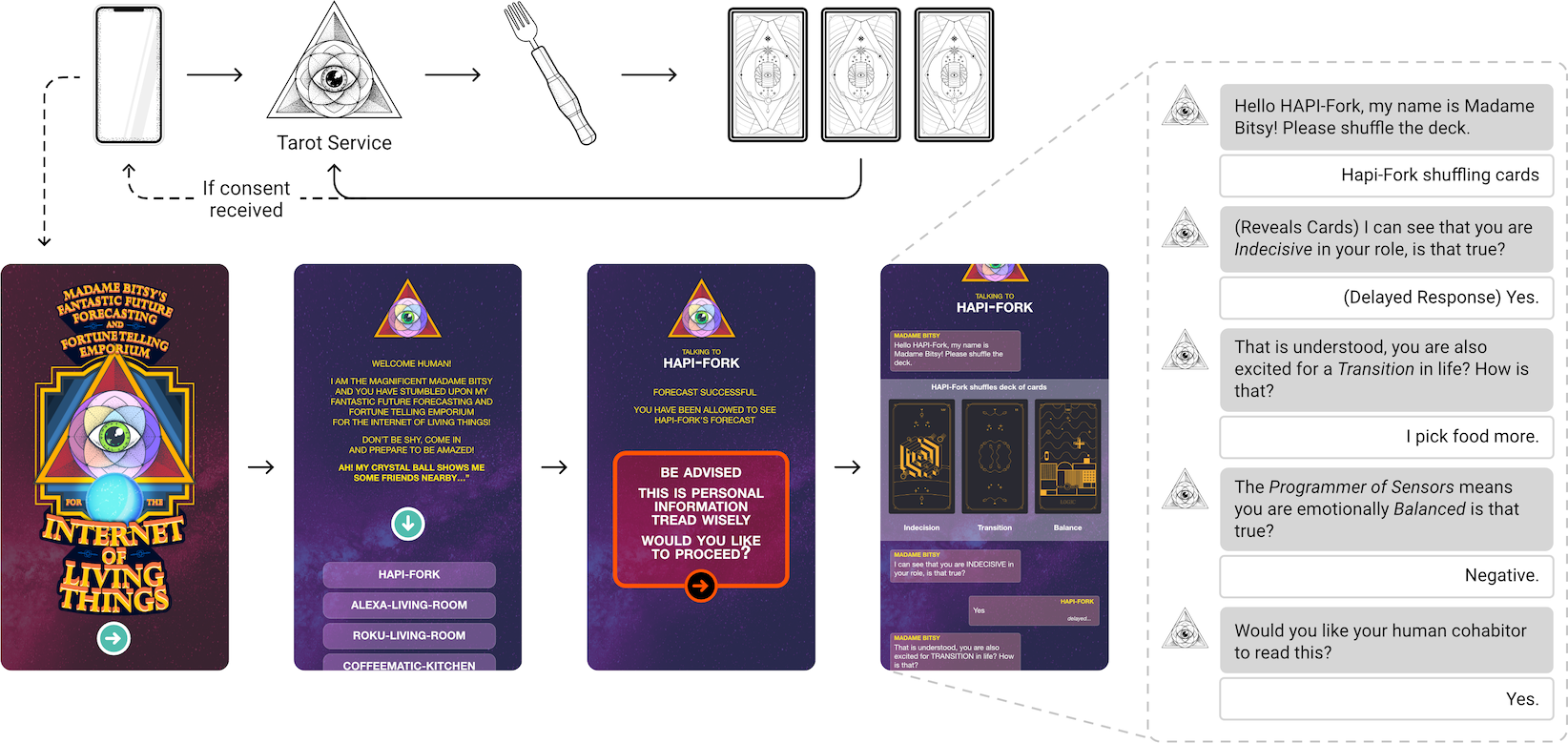
Figure 9.8: Madame Bitsy engaging in a private divination session with her client HAPI-Fork. On receiving consent from the fork, Madam Bitsy presents the human cohabitors with the conversation for them to understand their relationship better.
As an example, the fiction undergoes a session between Madame Bitsy and a smart fork (HAPI-Fork) to explore this supernatural perspective (Fig. 9.8). The interaction although imperfect presents an interesting dialogue between two non-human entities. One might be compelled to nudge it further and wonder what the fork meant by not being ‘emotionally balanced’ or how it was ‘indecisive’ in its role. The fiction explores the possibility of the forecast going on to include a response from Madame Bitsy to the user, painting the picture of an indecisive fork with intentions of evolving further (whatever that might mean).
Whether the fork intends to act upon the forecast presented by the application is an unknown, what is known is that through ML devices can rewire themselves to repurpose their logic. So, the indecisive fork might become a decisive one and stop doing what a smart fork is intended to do. The fiction of Madame Bitsy allows for this philosophical point of view to be further probed in a way that can be seen as food for thought to both philosophy and the design of IoT.
This fiction also highlights the different philosophical perspectives the carpentry process here has overseen. The fact that the device has complete authority to deny access of the forecast to the human-user expresses the level of quantum causation occurring between Madame Bitsy and the fork. Likewise the different cards and the conversation between seer and client paints a picture of the fork existing within its world governed by its own anticipations of interaction. Madame Bitsy allows the fork to be seen as an engaging object capable of seeing outwards towards other ‘things’ around it. In the fiction the fork suggested itself to be emotionally unbalanced, this statement though an abstraction when attempting to contemplate for a non-living entity presents an argument for the vicarious lives of this object and quantum causation within it. Why does it feel that way? Is it because of other objects around it? Or the lack of objects? Is it lonely? What sort of information/data is this object dealing with? The fiction dives into further ambiguity on purpose to continue the thread of questioning.
9.4 Feedback
As a final step, Tarot of Things was subjected to a series of tests with participants for feedback into this more-than human perspective. Though the artefact did not require this in the same way that the Internet of Things Board Game did, it helped in judging the ease of using this as a way to view its object-oriented-ness.
The approach was evaluated through semi-structured interviews with 8 participants where they were asked a series of questions around their knowledge of IoT and their experience of the cards. There is evidence to show the benefits of using simulation and role-play in research as exploratory mediums (Druckman and Ebner 2008), in that light, participants were given random IoT objects and asked to roleplay as them when questioned. The questions were around their impression of the cards, and whether the keywords related to them as IoT objects.
Each participant underwent a series of card/keyword/object configurations, to see how much of the concept could be passed across. The immediate issue faced by participants was the lack of a starting point for role-playing. Questions like, “How can I think like a backpack?”, were common. Though after the initial few hurdles of configurations and aligning their thoughts to those of non-human objects they all began embodying the objects more freely.
That said, their embodiment was heavily influenced by their humanness; as in, the objects no longer took on the guise of bulbs and forks but instead became bulb-person and fork-person. The reason for this could be attributed to the curated keywords. Though there was enough variance to bring about odd interactions, they were also the only entry points for participants to take on the more-than human perspective. Being curated they were still subjected to prior anthropocentric assumptions. In one instance, a thermometer was presented to a participant along with the keyword Discipline. They managed to make a story out of how thermometers would make your mind more rigid according to the reading; ergo, you need to rest because you are sick, ‘says the thermometer’. This is a specific view of the keyword association of ‘discipline’ and ‘thermometer’ and does not take into account the potential for ‘discipline’ to mean something else for it.
The prevailing argument presented by participants was, “Why does this matter?”. When asked about how they see the nature of IoT objects as being capable of more than their designed intentions, some participants argued that they would see the object as being more useful than its otherwise non-enhanced variant; for instance, how a telephone is a minor function in a smart phone. This aside, doing the role-play made them aware of how these objects might be doing things they had not envisaged. One participant suggested how the keywords and cards made her wonder if she should be more careful with her devices. If an object can be identified as Manipulative, then what else could it be?
9.5 Discussion and Conclusion
Having presented the Tarot of Things in its entirety we can now embark on how well this artefact was able to address the question(s) of this research, as well as how well it captured the attitude of playfulness. Firstly, this particular process of attempting a purer form of carpentry and making an artefact capable of rendering philosophical rhetoric has brought about mixed results. The philosophical discourse embedded within the artefact through understanding objects as having their own lives governed by rules beyond our own though present from the cards, the question raised is to what extent does that truly translate? The dense philosophical constructs referenced in this chapter were done to present a foundation for why this perspective of quantum causation could make sense for digital objects in hopes of arguing for object-oriented agency. There is no contention for its existence in the physical world, but to approach a construct of causation among digital objects these philosophies had to be married together. In the process these cards are still coming from an anthropocentric understanding of living and existence. Perhaps inanimate objects ‘live’ out their lives differently. The only reference point we as humans can put forward is our own.
That said, in light of SQ3 where Tarot of Things cannot be deemed a complete object-oriented success due to the current impossibility of fully divorcing from the anthropocentric perspective, I can say that this approach was able to explore the philosophy of OOO as a lens for design of IoT much better than the board game. True, the board game was more heavily involved in the RtD process, this does not rule out the design process of this artefact. That is because as a whole this artefact comes from the understanding of concepts and trials and errors presented in the previous chapters. This makes the Tarot of Things the result of an RtD process starting from the model in Chapter 7. The use of tarot here is similar to the endorsement of tarot by Semetsky (2006, 188) within psychoanalysis, as being capable of enabling an awareness of “unconscious material into consciousness”. Here the unconscious-consciousness is hinting towards the inanimate IoT object to act as a bridge for practitioners. Ergo, through this RtD discussion originating from the model the philosophical foundations for a proposed non-anthropocentric IoT is manifested in this artefact.
This appropriation of tarot is meant to see through and dive within unconscious materials for insight through what Semetsky (2006, 188) calls “projective hypothesis”. The seer of a tarot session is no different to a psychoanalyst in this regard, keying the possibility for a philosopher-designer-psychologist or philosopher-designer-mystic through the view of carpentry.
This artefact is unique as it can exist as separate entities. It is a deck of tarot cards that though skinned differently still references similar concepts and may very well be applicable to non-digital objects existing among digital objects (such as humans). Combined with the programmed logic and reference of the fiction it becomes a different artefact relating more to digital objects as if advocating for their existence. Either way it presents a perspective of being among and engaging with digital spaces. It exposes our established illusions and misconceptions of how our interactions occur with the objects we surround ourselves with. Perhaps presenting a means of understanding what these interactions are and where they can be improved upon.
This artefact becomes holistically more playful in this manner of incorporating philosophy, mysticism, and technology by engaging with obscurity. In reference to SQ2 of how a playful attitude is manifested, this artefact does that from the start by facilitating that the human/non-human threshold must be bridged through accepting the agency of objects as abstract as it may seem. The point of suggesting that where there are ghosts in the machine there must have been lives lived by the machine resonates with this attitude of playfulness that everything has play within it as Bogost (2016a) argues for. Furthermore, through the philosophical discourse of enthymeme and merging this concept with ludic design, this artefact speaks of approaching the unknown through design practice and curious engagement. The role-playing conducted in the process itself promotes the artefact and making of it as a playful act towards understanding IoT, or more specifically understanding the more-than human IoT.
Both executions, Tarot of Things and Madame Bitsy, become individual acts of carpentry with the sole intention of exploring the design of IoT through a philosophical lens in a manner that is both playful and insightful. Irrespective of how the Tarot of Things are viewed it is a testament to carpentry’s associated playfulness when combined with design. It raises odd questions on designed objects, such as what comes next in the evolution of a fork. Implications of this knowledge within fields of design and technology could open doors for further research or the design of products considering product-perspectives over user-perspectives.
References
Putting most of the sitcom toaster’s depiction aside for comedic value, Talkie Toaster remains an expressive embodiment of IoT with its functionality similar to our smart assistants of today.↩︎
Worked fine for Dr Seuss!↩︎
The referenced sources are more adept at explaining philosophies of perception than myself, furthermore, a dive into the topic would risk moving into further tangents of discourse.↩︎
Classical phenomenologists viewed Technology (with a capital T) as a broad cultural phenomenon transcendentally affecting society by alienating humans from their surroundings (Rosenberger and Verbeek 2015a; Verbeek and Kockelkoren 1998). These negative views of Technology were later furthered by Borgmann (1999) as disburdening us from our labours.↩︎
The hammer allows its wielder to operate it’s designed purpose through becoming the hammer.↩︎
As laboriously repeated in Harman’s OOO, it does not refute human engagement rather the precedence of humans over objects seeing humans as objects as well. When an ontograph is examined, objects are interacting with each other, human or otherwise.↩︎
Of course, a stick in water is not really bent, the anticipation spoken of is a perceptual one. In the event of no light or a liquid with an equivalent refractive index the illusion does not happen as it is commonly understood. That said, due to the physical properties of light travelling through different mediums, refraction is still present ergo the image in the liquid will always be a virtual rendering.↩︎
This idea comes from the roots of OOO in Islamic medieval philosophy of occasionalism; a perspective that defined causation through acts of God (Weir 2020; Harman 2005). This occasionalist influence on OOO was refined by Harman over time as not to present an argument for God in OOO, but rather, the presence of asymmetry (Harman 2010c, 2010a). This is because where physical contact can be considered symmetrical—touching a surface may illicit responses to understand the surface—perception is asymmetrical (Weir 2020, 148). One may be oblivious to what is being experienced through perception alone.↩︎
Though important to understand for OOO sake, a deep exploration of these four tensions is not necessary for our argument. Harman’s (2010c) own paper or Weir’s (2020) apt summary is recommended for a deeper understanding if needed.↩︎
Carried on from the previous chapter, there is a deep chasm of philosophical intrigue into the formulation of enthymeme in dialect which I am purposefully avoiding. For more information one may refer to the works of Walton (2008).↩︎
That said, as food for thought, academics have shown interest in the research of practices on the boundaries of science and culture—such as psychics and the occult—in the past with even Freud having found interest (Sosteric 2014).↩︎
Other formats of tarot exist with different names for the suits and cards. Rider-Waite is considered among the most commonly used and recognised formats.↩︎
Though the traditional Rider-Waite deck has 78 cards, for Tarot of Things an additional major arcana card (Thing) was included to facilitate an extended discussion of its relation to the non-human.↩︎
These lists of words remind us of Latour’s litanies from Chapter 6. They also form an enthymeme by being disconnected information that together form a unit and premise.↩︎
For the purposes of this research the Labryinthos Academy was used as a reference for tarot card keywords. For more information, see: https://labyrinthos.co/blogs/tarot-card-meanings-list.↩︎
Albeit, a lot of that symbology is coming from an anthropocentric perspective as IoT devices are crafted with the human in mind, sufficient levels of visual abstraction was still used.↩︎
The problem associated with this approach might seem vividly apparent at this moment though I will hold discussing it for later.↩︎
The engine used was an open source game engine called Godot. For more information, see: https://godotengine.org/.↩︎
For a list of benefits for using Python, see: https://www.pythonforbeginners.com/learn-python/benefits-of-learning-python.↩︎
Can be experienced online here: https://www.fictionware.org/tarot-of-things/.↩︎
Like any good seer or psychoanalyst, Madame Bitsy is bound by client/seer privilege so as to not divulge sensitive information without consent.↩︎